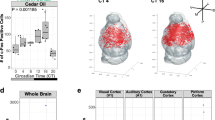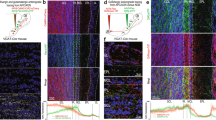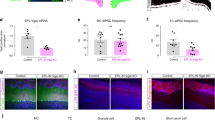Abstract
Odor stimulation evokes complex spatiotemporal activity in the olfactory bulb, suggesting that both the identity of activated neurons and the timing of their activity convey information about odors. However, whether and how downstream neurons decipher these temporal patterns remains unknown. We addressed this question by measuring the spiking activity of downstream neurons while optogenetically stimulating two foci in the olfactory bulb with varying relative timing in mice. We found that the overall spike rates of piriform cortex neurons (PCNs) were sensitive to the relative timing of activation. Posterior PCNs showed higher sensitivity to relative input times than neurons in the anterior piriform cortex. In contrast, olfactory bulb neurons rarely showed such sensitivity. Thus, the brain can transform a relative time code in the periphery into a firing rate–based representation in central brain areas, providing evidence for the relevance of a relative time–based code in the olfactory bulb.
This is a preview of subscription content, access via your institution
Access options
Subscribe to this journal
Receive 12 print issues and online access
$209.00 per year
only $17.42 per issue
Buy this article
- Purchase on Springer Link
- Instant access to full article PDF
Prices may be subject to local taxes which are calculated during checkout








Similar content being viewed by others
References
Adrian, E.D. The impulses produced by sensory nerve endings: part I. J. Physiol. (Lond.) 61, 49–72 (1926).
Wehr, M. & Laurent, G. Odour encoding by temporal sequences of firing in oscillating neural assemblies. Nature 384, 162–166 (1996).
VanRullen, R., Guyonneau, R. & Thorpe, S.J. Spike times make sense. Trends Neurosci. 28, 1–4 (2005).
Laurent, G. A systems perspective on early olfactory coding. Science 286, 723–728 (1999).
Hopfield, J.J. Pattern recognition computation using action potential timing for stimulus representation. Nature 376, 33–36 (1995).
Spors, H. & Grinvald, A. Spatio-temporal dynamics of odor representations in the mammalian olfactory bulb. Neuron 34, 301–315 (2002).
Wesson, D.W., Carey, R.M., Verhagen, J.V. & Wachowiak, M. Rapid encoding and perception of novel odors in the rat. PLoS Biol. 6, e82 (2008).
Macrides, F. & Chorover, S.L. Olfactory bulb units: activity correlated with inhalation cycles and odor quality. Science 175, 84–87 (1972).
Cang, J. & Isaacson, J.S. In vivo whole-cell recording of odor-evoked synaptic transmission in the rat olfactory bulb. J. Neurosci. 23, 4108–4116 (2003).
Margrie, T.W. & Schaefer, A.T. Theta oscillation coupled spike latencies yield computational vigor in a mammalian sensory system. J. Physiol. (Lond.) 546, 363–374 (2003).
Shusterman, R., Smear, M.C., Koulakov, A.A. & Rinberg, D. Precise olfactory responses tile the sniff cycle. Nat. Neurosci. 14, 1039–1044 (2011).
Cury, K.M. & Uchida, N. Robust odor coding via inhalation-coupled transient activity in the mammalian olfactory bulb. Neuron 68, 570–585 (2010).
Blumhagen, F. et al. Neuronal filtering of multiplexed odor representations. Nature 479, 493–498 (2011).
Smear, M., Shusterman, R., O'Connor, R., Bozza, T. & Rinberg, D. Perception of sniff phase in mouse olfaction. Nature 479, 397–400 (2011).
Miura, K., Mainen, Z.F. & Uchida, N. Odor representations in olfactory cortex: distributed rate coding and decorrelated population activity. Neuron 74, 1087–1098 (2012).
Kadohisa, M. & Wilson, D.A. Olfactory cortical adaptation facilitates detection of odors against background. J. Neurophysiol. 95, 1888–1896 (2006).
Stettler, D.D. & Axel, R. Representations of odor in the piriform cortex. Neuron 63, 854–864 (2009).
Luna, V.M. & Schoppa, N.E. GABAergic circuits control input-spike coupling in the piriform cortex. J. Neurosci. 28, 8851–8859 (2008).
Apicella, A., Yuan, Q., Scanziani, M. & Isaacson, J.S. Pyramidal cells in piriform cortex receive convergent input from distinct olfactory bulb glomeruli. J. Neurosci. 30, 14255–14260 (2010).
Davison, I.G. & Ehlers, M.D. Neural circuit mechanisms for pattern detection and feature combination in olfactory cortex. Neuron 70, 82–94 (2011).
Dhawale, A.K., Hagiwara, A., Bhalla, U.S., Murthy, V.N. & Albeanu, D.F. Non-redundant odor coding by sister mitral cells revealed by light addressable glomeruli in the mouse. Nat. Neurosci. 13, 1404–1412 (2010).
Arenkiel, B.R. et al. In vivo light-induced activation of neural circuitry in transgenic mice expressing channelrhodopsin-2. Neuron 54, 205–218 (2007).
Carey, R.M., Verhagen, J.V., Wesson, D.W., Pirez, N. & Wachowiak, M. Temporal structure of receptor neuron input to the olfactory bulb imaged in behaving rats. J. Neurophysiol. 101, 1073–1088 (2009).
Wachowiak, M. All in a sniff: olfaction as a model for active sensing. Neuron 71, 962–973 (2011).
Uchida, N. & Mainen, Z.F. Speed and accuracy of olfactory discrimination in the rat. Nat. Neurosci. 6, 1224–1229 (2003).
Davison, I.G. & Katz, L.C. Sparse and selective odor coding by mitral/tufted neurons in the main olfactory bulb. J. Neurosci. 27, 2091–2101 (2007).
Nagayama, S., Takahashi, Y.K., Yoshihara, Y. & Mori, K. Mitral and tufted cells differ in the decoding manner of odor maps in the rat olfactory bulb. J. Neurophysiol. 91, 2532–2540 (2004).
Benjamini, Y. & Hochberg, Y. Controlling the false discovery rate: a practical and powerful approach to multiple testing. J. R. Stat. Soc. Series B Stat. Methodol. 57, 289–300 (1995).
Stokes, C.C. & Isaacson, J.S. From dendrite to soma: dynamic routing of inhibition by complementary interneuron microcircuits in olfactory cortex. Neuron 67, 452–465 (2010).
Suzuki, N. & Bekkers, J.M. Microcircuits mediating feedforward and feedback synaptic inhibition in the piriform cortex. J. Neurosci. 32, 919–931 (2012).
Satou, M., Mori, K., Tazawa, Y. & Takagi, S.F. Interneurons mediating fast postsynaptic inhibition in pyriform cortex of the rabbit. J. Neurophysiol. 50, 89–101 (1983).
Poo, C. & Isaacson, J.S. Odor representations in olfactory cortex: “sparse” coding, global inhibition, and oscillations. Neuron 62, 850–861 (2009).
Buck, L.B. The molecular architecture of odor and pheromone sensing in mammals. Cell 100, 611–618 (2000).
Mori, K. & Sakano, H. How is the olfactory map formed and interpreted in the Mammalian brain? Annu. Rev. Neurosci. 34, 467–499 (2011).
Stopfer, M., Jayaraman, V. & Laurent, G. Intensity versus identity coding in an olfactory system. Neuron 39, 991–1004 (2003).
Perez-Orive, J. et al. Oscillations and sparsening of odor representations in the mushroom body. Science 297, 359–365 (2002).
Carey, R.M. & Wachowiak, M. Effect of sniffing on the temporal structure of mitral/tufted cell output from the olfactory bulb. J. Neurosci. 31, 10615–10626 (2011).
Junek, S., Kludt, E., Wolf, F. & Schild, D. Olfactory coding with patterns of response latencies. Neuron 67, 872–884 (2010).
Schaefer, A.T. & Margrie, T.W. Spatiotemporal representations in the olfactory system. Trends Neurosci. 30, 92–100 (2007).
Haberly, L.B. Summed potentials evoked in opossum prepyriform cortex. J. Neurophysiol. 36, 775–788 (1973).
Franks, K.M. et al. Recurrent circuitry dynamically shapes the activation of piriform cortex. Neuron 72, 49–56 (2011).
Poo, C. & Isaacson, J.S. A major role for intracortical circuits in the strength and tuning of odor-evoked excitation in olfactory cortex. Neuron 72, 41–48 (2011).
Hagiwara, A., Pal, S.K., Sato, T.F., Wienisch, M. & Murthy, V.N. Optophysiological analysis of associational circuits in the olfactory cortex. Front. Neural Circuits 6, 18 (2012).
Mouly, A.M., Litaudon, P., Chabaud, P., Ravel, N. & Gervais, R. Spatiotemporal distribution of a late synchronized activity in olfactory pathways following stimulation of the olfactory bulb in rats. Eur. J. Neurosci. 10, 1128–1135 (1998).
Oswald, A.M. & Urban, N.N. Interactions between behaviorally relevant rhythms and synaptic plasticity alter coding in the piriform cortex. J. Neurosci. 32, 6092–6104 (2012).
Suzuki, N. & Bekkers, J.M. Neural coding by two classes of principal cells in the mouse piriform cortex. J. Neurosci. 26, 11938–11947 (2006).
Branco, T., Clark, B.A. & Hausser, M. Dendritic discrimination of temporal input sequences in cortical neurons. Science 329, 1671–1675 (2010).
Bathellier, B., Margrie, T.W. & Larkum, M.E. Properties of piriform cortex pyramidal cell dendrites: implications for olfactory circuit design. J. Neurosci. 29, 12641–12652 (2009).
Padmanabhan, K. & Urban, N.N. Intrinsic biophysical diversity decorrelates neuronal firing while increasing information content. Nat. Neurosci. 13, 1276–1282 (2010).
Angelo, K. et al. A biophysical signature of network affiliation and sensory processing in mitral cells. Nature 488, 375–378 (2012).
Madisen, L. et al. A toolbox of Cre-dependent optogenetic transgenic mice for light-induced activation and silencing. Nat. Neurosci. 15, 793–802 (2012).
Yang, X.W., Model, P. & Heintz, N. Homologous recombination based modification in Escherichia coli and germline transmission in transgenic mice of a bacterial artificial chromosome. Nat. Biotechnol. 15, 859–865 (1997).
Schmitzer-Torbert, N. & Redish, A.D. Neuronal activity in the rodent dorsal striatum in sequential navigation: separation of spatial and reward responses on the multiple T task. J. Neurophysiol. 91, 2259–2272 (2004).
Boyden, E.S., Zhang, F., Bamberg, E., Nagel, G. & Deisseroth, K. Millisecond-timescale, genetically targeted optical control of neural activity. Nat. Neurosci. 8, 1263–1268 (2005).
Acknowledgements
We thank C. Dulac (Harvard University) for sharing resources generously, comments on the manuscript and providing Tbet-cre; ChR2loxP/loxP mice (generated by A.L.). We thank E. Soucy and T. Sato for technical support and D.F. Albeanu and A.K. Dhawale for technical advice. We thank Y. Ben-Shaul, C. Poo, N. Eshel and J.Y. Cohen for their comments on the manuscript. This work was supported by Human Frontier Science Program (R.H.), a Howard Hughes Medical Institute Collaborative Innovation Award, a Smith Family New Investigator Award, the Alfred Sloan Foundation and the Milton Fund (N.U.), and a grant from the US National Institutes of Health (V.N.M.).
Author information
Authors and Affiliations
Contributions
R.H. and N.U. conceived the experiment. R.H. performed the experiment. A.L. generated and characterized the Tbet-cre; ChR2loxP/loxP mice, and L.M. and H.Z. generated and characterized the ChR2loxP/loxP mice. V.N.M. provided the Omp-ChR2 mice. R.H. and N.U. wrote the paper and A.L., V.N.M. and H.Z. provided feedback on the manuscript.
Corresponding author
Ethics declarations
Competing interests
The authors declare no competing financial interests.
Supplementary information
Supplementary Text and Figures
Supplementary Figures 1–10 (PDF 5930 kb)
Rights and permissions
About this article
Cite this article
Haddad, R., Lanjuin, A., Madisen, L. et al. Olfactory cortical neurons read out a relative time code in the olfactory bulb. Nat Neurosci 16, 949–957 (2013). https://doi.org/10.1038/nn.3407
Received:
Accepted:
Published:
Issue Date:
DOI: https://doi.org/10.1038/nn.3407
This article is cited by
-
Robust encoding of natural stimuli by neuronal response sequences in monkey visual cortex
Nature Communications (2023)
-
A combinatorial code of neurexin-3 alternative splicing controls inhibitory synapses via a trans-synaptic dystroglycan signaling loop
Nature Communications (2023)
-
Biological Codes: A Field Guide for Code Hunters
Biological Theory (2023)
-
Functional and multiscale 3D structural investigation of brain tissue through correlative in vivo physiology, synchrotron microtomography and volume electron microscopy
Nature Communications (2022)
-
Long-range GABAergic projections contribute to cortical feedback control of sensory processing
Nature Communications (2022)



